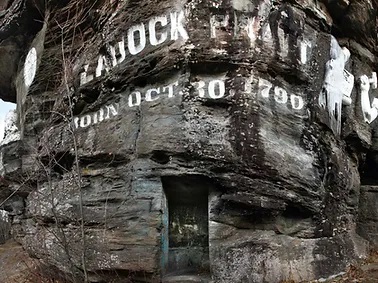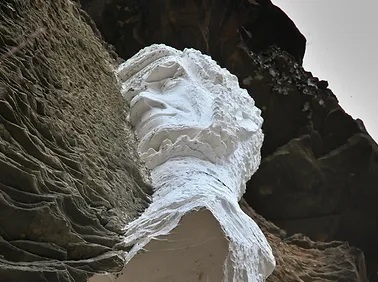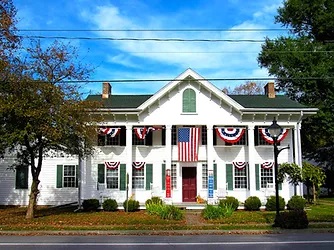Interview with Prattsville Town Supervisor Greg Cross
Pratt Rock, also known as Pratt's Rock, is a rock face or other land form that includes a series of stone carvings in Prattsville, New York depicting the life of Zadock Pratt. Pratt was supposed to be buried in a tomb carved into the stone, but work was stopped after only a small recessed chamber was created because water leaked through the rock overhead, and excavating the stone was providing to be too difficult. The rock was originally a monument for Pratt's son, George W. Pratt, who was killed in the Civil War. It is considered the first memorial for the Civil War.
Pratt Rock Park is open to the public every day, and there in no admission fee. The climb to the rocks is steep, and may be unfit for young children, but the path is clear and ascends in a series of gently graded inclines to the carved cliff wall 500 feet above the road. The stonecutters hacked chairs and benches out of the rocks along the way, and picnicking is permitted, so take your time and enjoy the ascent in a relaxed and thoughtful manner. The sculptures and the view of the valley make the short climb more than worth the effort.
 Ripley's " Believe It or Not" called Pratt Rock "New York's Mt. Rushmore". Another, less generous appraisal termed it "a monument to vanity". Town Founder Zadock Pratt called it the story of his town written in stone. Pratt Rock Park, by the side of State Route 23 on the outskirts of Prattsville, like many other points of interest in the Catskill Mountains, seems to attract widely varying opinions. Its story, like the Catskills themselves, is cloaked in legend. The story goes that a poor stone cutter passing through the village of Prattsville in 1843 panhandled the town's foremost citizen, wealthy landowner/ entrepreneur/ statesman Zadock Pratt, who was known for his largess. Pratt was also known for his belief in the salutary effects of hard work, and in return for his modest donation (reportedly fifty centers), set the man to work carving the Abraham Lincoln-ish profile of Pratt high above the village in the town.
Ripley's " Believe It or Not" called Pratt Rock "New York's Mt. Rushmore". Another, less generous appraisal termed it "a monument to vanity". Town Founder Zadock Pratt called it the story of his town written in stone. Pratt Rock Park, by the side of State Route 23 on the outskirts of Prattsville, like many other points of interest in the Catskill Mountains, seems to attract widely varying opinions. Its story, like the Catskills themselves, is cloaked in legend. The story goes that a poor stone cutter passing through the village of Prattsville in 1843 panhandled the town's foremost citizen, wealthy landowner/ entrepreneur/ statesman Zadock Pratt, who was known for his largess. Pratt was also known for his belief in the salutary effects of hard work, and in return for his modest donation (reportedly fifty centers), set the man to work carving the Abraham Lincoln-ish profile of Pratt high above the village in the town.
 Pratt liked the stonecutter's work so much (the story goes), and his vanity was tickled by his likeness now presiding over the fertile valley of the Schoharie Kill, that he retained the stonecutter to carve emblems depicting Pratt's life story in the rock surrounding his profile:
Pratt liked the stonecutter's work so much (the story goes), and his vanity was tickled by his likeness now presiding over the fertile valley of the Schoharie Kill, that he retained the stonecutter to carve emblems depicting Pratt's life story in the rock surrounding his profile:
- A horse and a hemlock tree (key resources in the building of the Pratt leather-tanning fortune).
- The tannery itself (with the legend, one million sides of sole leather tanned with hemlock bark, in twenty years by Z. Pratt).
- The Pratt coat of arms with the motto " Do well and doubt not", and a wreath containing the names of two of his children, George W. and Julia H. ( a third child, unmemorialized in the rock had died in infancy). The wreath originally contained the hopeful blessing " Let virtue be your greatest care and study your delighs. Wo will your days be ever fair and peacable your night". The verse was later removed, some time after George was slain in 1862 by confederate cannon fire at the second battle of Manassas (Bull Run).
Destroyed, along with George, in that rebel fusillade, were the elder Pratt's dreams of turning over his vast commercial (almost baronial) empire to his son and heir. Whether the relief sculptures of stonecutter, or whether they had been planned for years as a monument to himself by a man who had already imprinted his name on village and township, the rocks, with George's death, became a father's memorial to a dead son.
Under the bust of Zadock is a brief legend, Zadock Pratt ? Born Oct. 30th, 1970 while George was given much more copy: Hon. G.W Pratt, Ph.D/ Colxx regt., N.Y.S.M., Ulster Co., Born April 18 1830? Wounded Aug 30 in the second battle of Manassas, VA died at Albany, NY Sep. 11th. Good Brave Honorable 1862.
 George was a boy of 13 when the sculptures began. No doubt the elder Pratt often took his son to the park to watch the familiar features of his father, a horse (most probably Zadock Pratt's beloved gray, Prince), a tree and a tannery that defined his small world of Prattsville form like magic from the featureless gray rock. No doubt, also, the elder Pratt would tell his son how this accomplishment also ( and his son's after him) would one day be carved in the rocks to testify their adherence to doing well and doubting not.
George was a boy of 13 when the sculptures began. No doubt the elder Pratt often took his son to the park to watch the familiar features of his father, a horse (most probably Zadock Pratt's beloved gray, Prince), a tree and a tannery that defined his small world of Prattsville form like magic from the featureless gray rock. No doubt, also, the elder Pratt would tell his son how this accomplishment also ( and his son's after him) would one day be carved in the rocks to testify their adherence to doing well and doubting not.
The pact was sealed, George did well ( a doctorate, a term in the NY State Senate, and a Union colonelcy) and he doubted not, as he left for Washington and pointed south at the head of a regiment of militia. Afterwards, his father duly commissioned George's vital statistics carved in the rocks where their sandstone images look at each other for eternity. Between them was carved an uplifted right hand and the motto: THIS HAND FOR MY COUNTY.
There are other carvings in Pratt Rock Park including one of an arm raising a hammer (not unlike the baking soda emblem but a story to be told at a later date), but the father and son tableau hold center court.
 There is even a small recessed chamber at path level by the cliff, carved as a tomb for Zadock. That idea was abandoned, it is said, because the stonecutter found the task too difficult and water leached into the chamber. But perhaps as the years progressed and the rocks become more of a memorial to George than to Zadock, the surviving Pratt stepped out of the spotlight and chose conventional interment in the villages Benham Cemetery.
There is even a small recessed chamber at path level by the cliff, carved as a tomb for Zadock. That idea was abandoned, it is said, because the stonecutter found the task too difficult and water leached into the chamber. But perhaps as the years progressed and the rocks become more of a memorial to George than to Zadock, the surviving Pratt stepped out of the spotlight and chose conventional interment in the villages Benham Cemetery.
A dynasty-in-the-making died with Zadock a few years later in 1871. He had come to the western Catskills as a small boy in the early years of the 19th century. He worked hard, saved his money, and built from scratch a huge tanning business which made him very wealthy in just 20 years. Then he retired from tanning to pursue various other commercial enterprises, squire about his grand 350-acre farm, and campaign for public office (which he did successfully, including two productive terms in Congress).
The family fortune was made, the family was well connected and esteemed, and the heir apparent was groomed and educated for great things, but the war that could have launched a formidable political career for a conquering hero of the Republic, had George survived, instead brought down the House of Pratt like a house of cards. George was just one more casualty of a brutal war, and Zadock became a footnote to history.
 Please take a moment to read about the future of Pratt Rock
Please take a moment to read about the future of Pratt Rock
Pratt Rock Park Initial Concept Plan
Pratt Rock Park Initial Needs Assessment

